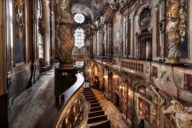
Asamkirche on Sendlinger Strasse, with its splendid facade, is one of southern Germany’s most significant late Baroque buildings.
Asamkirche was built between 1733 and 1746 by brothers Cosmas Damian and Egid Quirin Asam. Its official name is St.-Johann-Nepomuk-Kirche. The two-storey building, measuring 22 x 8 metres, blends in well amid the terraced houses of Sendlinger Straße.
The brothers had originally intended for the church to be a private chapel, but soon opened it to the public after the vehement insistence of the population. Since Asamkirche was a private building, the brothers were able to enjoy free rein when it came to the design.
The interior is divided into three levels: the area in which church visitors sit is relatively dark and gloomy: it symbolises worldly suffering. The higher up you look – and therefore the closer you get to the heavens – the brighter the church becomes. The middle level is decorated in white and blue, and was reserved for the Emperor. This also symbolises the hierarchy of the time, as it sets the Emperor above the people. The brightly lit top level opens onto the sky and is dedicated to God and eternity. The church was designed as a confession church, so it contains several confessionals, and masses are also held here on a regular basis.
Tip: The Asamhaus, in which the Asam brothers resided during the 18th century, is located directly beside Asamkirche. The palace is a masterpiece of Late Baroque architecture, but can only be viewed from the outside.